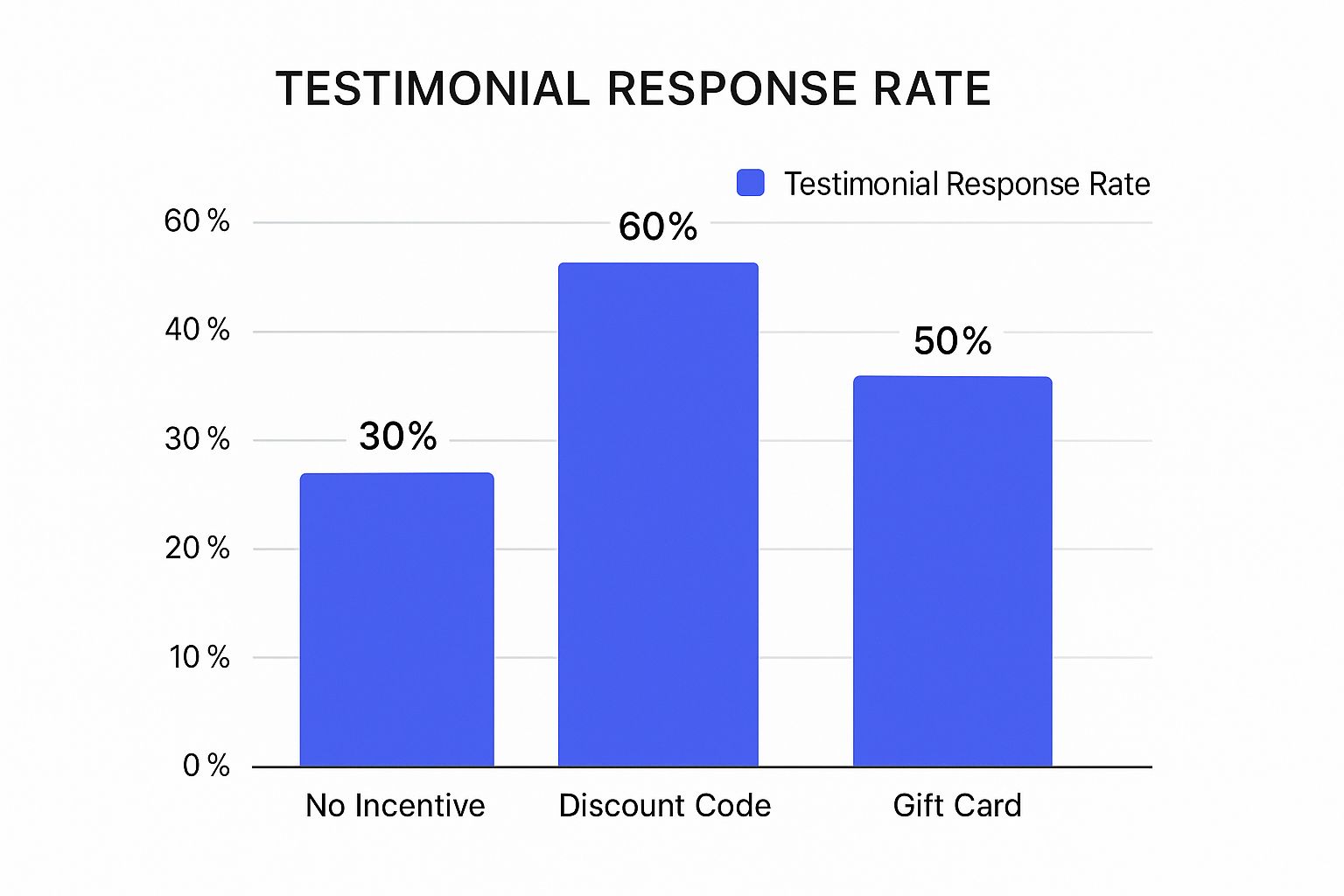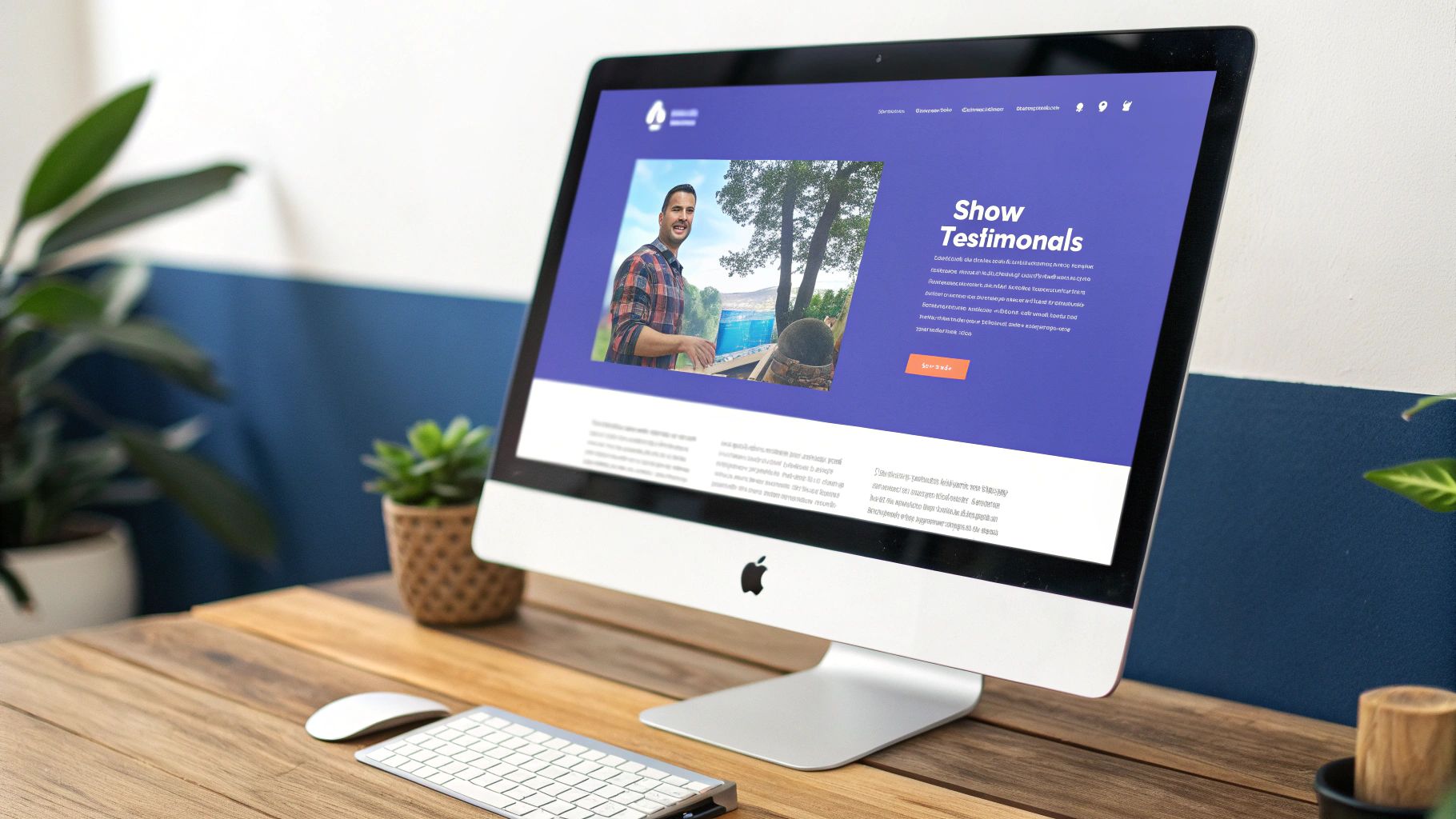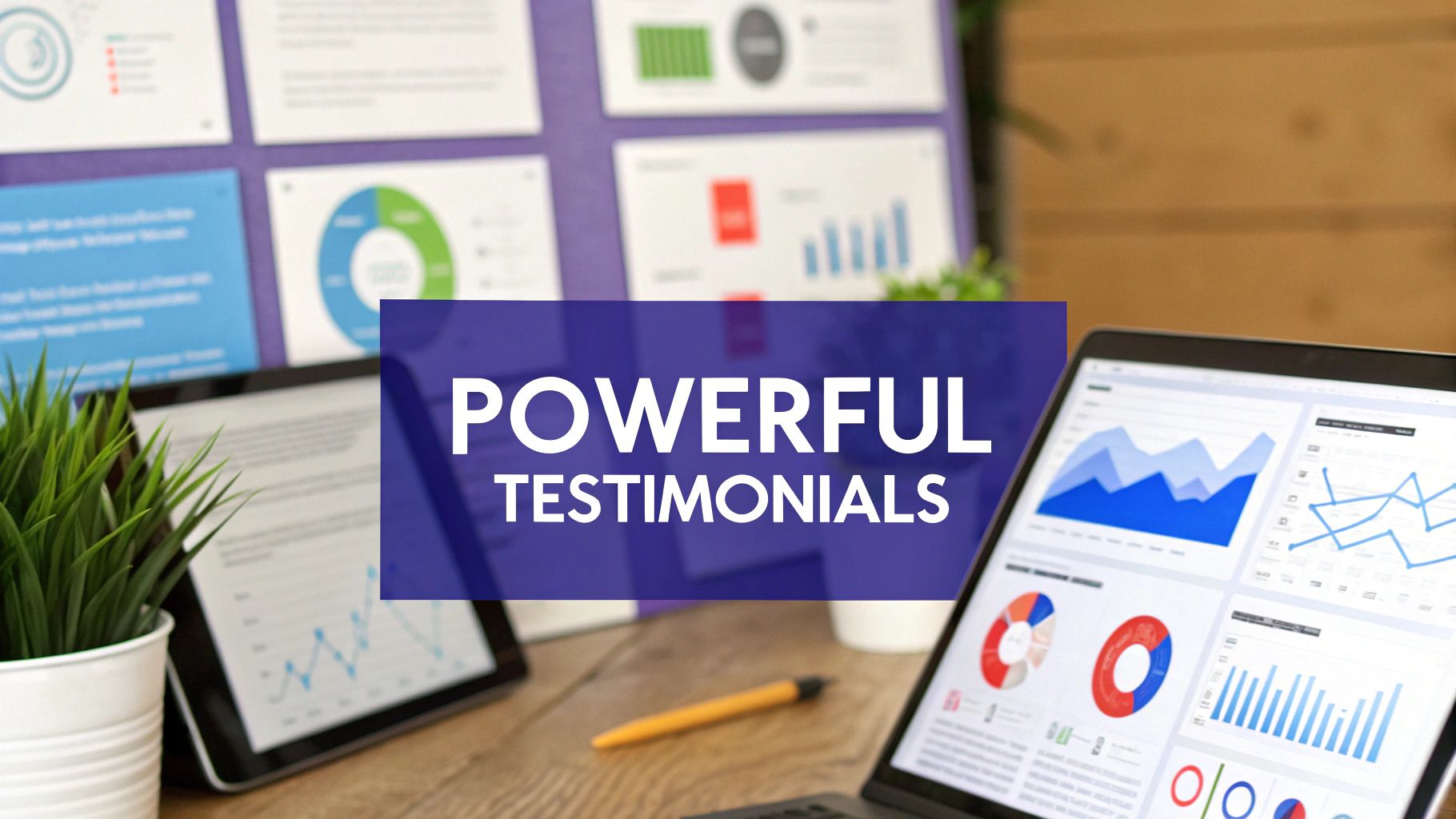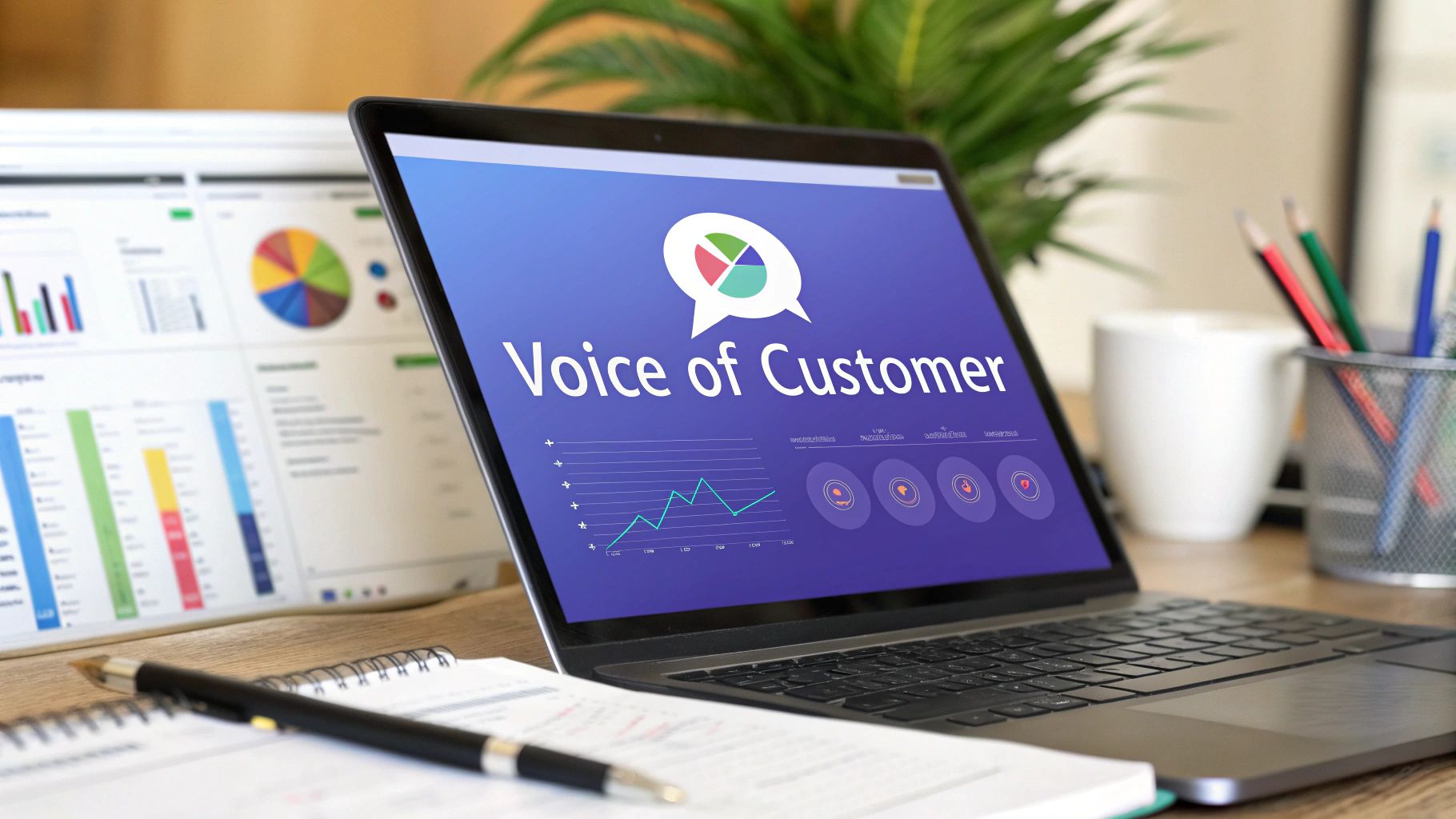How to Get Customer Testimonials: Expert Tips to Boost Trust
Learn how to get customer testimonials that increase trust and sales with simple, proven techniques. Start collecting powerful social proof today!

The Business Impact of Strategic Testimonials
Testimonials are more than just positive feedback; they provide social proof, building trust with potential customers by validating your claims. This trust is incredibly valuable in today's busines environment, where consumers face countless choices. But how can testimonials lead to tangible business results?
Testimonials and the Psychology of Trust
Testimonials leverage psychological principles that influence buying decisions. They offer reassurance and minimize perceived risk. When potential customers see positive experiences shared by others, they feel more confident about choosing your product or service. This is especially important for expensive purchases or services where trust is paramount. For instance, choosing a SaaS provider often involves researching and reading testimonials from similar businesses.
Quantifying the Impact of Testimonials
The effectiveness of testimonials can be measured using key performance indicators (KPIs). A significant 72% of customers report increased trust in a business after reading positive reviews and testimonials. More detailed statistics can be found here. This heightened trust directly impacts sales. Businesses showcasing online reviews and testimonials can see sales increases of up to 270%. Testimonials also improve website conversion rates, lower customer acquisition costs, and increase customer lifetime value. To optimize your approach, consider your current customer satisfaction measurement strategies.
To illustrate the impact of testimonials, let's examine some data:
The table below shows a comparison of key business metrics before and after implementing customer testimonials.
Business MetricWithout TestimonialsWith TestimonialsPercentage IncreaseWebsite Conversion Rate1.5%4.0%166.7%Sales Revenue$50,000$135,000170%Customer Acquisition Cost$100$70-30%Customer Lifetime Value$500$75050%
As you can see, incorporating testimonials has significantly improved these metrics. The increase in conversion rates and sales revenue, combined with the decrease in customer acquisition cost and the rise in customer lifetime value, demonstrates the strong positive impact testimonials can have on business performance.
Real-World Examples of Testimonial Success
Many businesses have achieved impressive results by strategically using testimonials. Some report substantial conversion rate improvements after adding testimonials to landing pages. Others have seen sales climb after featuring customer success stories on their websites. These real-world examples highlight the power of testimonials to drive business growth.

Building a Testimonial-Driven Business
Integrating testimonials should be a core element of your marketing strategy. By understanding their psychological influence and incorporating them strategically, you build trust, increase conversions, and achieve substantial business growth. This requires a shift from passively collecting customer feedback to actively seeking and showcasing it.
Creating Experiences Worth Talking About
Customer testimonials don't just appear out of thin air. They're built on a foundation of positive experiences. Think of it like this: crafting a delicious cake requires the right ingredients and a careful process. Similarly, creating experiences worthy of testimonials requires a strategic approach, focusing on key moments throughout the customer journey. These are the opportunities to exceed expectations and inspire organic testimonials.
Engineering Shareable Moments
Personalization is a crucial ingredient for a great customer experience. Much like a baker adjusts a recipe to individual tastes, businesses should tailor interactions to each customer's unique needs. This might involve personalized product recommendations or proactive, tailored support. Anticipatory service, anticipating customer needs before they arise, is another key element. This demonstrates proactive care and builds a strong sense of value, making positive feedback more likely.
For instance, a software company could proactively offer new users personalized onboarding resources based on their stated goals. This demonstrates care and anticipates their needs, potentially leading to positive testimonials about the company's helpfulness. A thoughtful follow-up after a purchase can also solidify a positive experience and encourage customers to share their stories. This could be a personalized thank you note, a feedback request, or an exclusive offer for future purchases.
The Importance of Customer Experience
The connection between customer experience and testimonials is clear: statistics show that 52% of customers will switch to a competitor after a single negative experience. Clearly, gathering testimonials requires more than just a great product; it requires exceptional customer service throughout the entire buyer's journey. Find more detailed statistics here. Customer testimonials, much like personal testimonies, highlight the impact of a product or service. The power of personal stories is evident in resources like Bible Verses By Topic - Testimony.
Measuring Experiences Against Goals
To ensure your efforts are effective, you need a system for measuring these experiences against your testimonial goals. This might involve tracking customer satisfaction scores, monitoring online reviews, and analyzing the content of received testimonials. This data provides valuable insights into what's working and what needs improvement. For instance, if testimonials frequently mention a particular feature or interaction, that highlights a strength to emphasize. Conversely, recurring negative feedback points to areas needing attention. By analyzing this data, businesses can continuously refine their approach to creating experiences worth talking about, ultimately generating more and better customer testimonials.
Perfect Timing: When to Ask for Powerful Feedback
Asking for a customer testimonial is like asking someone for a dance – timing is everything. A poorly timed request can be met with a resounding "no," while the perfect moment can lead to a glowing review that sings your praises. Understanding the psychology of timing is key to getting more responses and better testimonials. It's all about strategically choosing the right moment to ask, based on cues from your customers.
Recognizing the Signals of Testimonial Readiness
Knowing when to ask for a testimonial comes down to recognizing key emotional and behavioral signals. A customer expressing satisfaction, either directly or through positive social media engagement, is a prime example. Another great indicator is the successful completion of a project or achievement of a milestone using your product or service. Think of it as celebrating a win – the positive feelings associated with success make customers more inclined to share their experience.
Trigger-Based Systems for Identifying Opportunities
Top brands have moved beyond manual identification and adopted trigger-based systems. These systems use customer data and behavioral patterns to pinpoint ideal opportunities. For example, when a customer reaches a specific goal within your software or makes a repeat purchase, the system automatically sends a testimonial request. This not only simplifies the process but also ensures timely outreach, capturing customer enthusiasm at its peak. For more helpful strategies, check out our guide on how to master requesting testimonials.
The Psychology of Timing and Its Impact
Timing significantly influences both the response rate and the quality of the testimonial. Asking for feedback immediately after a positive experience, while the feeling is still fresh, often results in more enthusiastic and detailed responses. However, giving customers time to fully experience the benefits of your product can also be advantageous. This balanced approach requires understanding your specific customer journey.
Creating a Timing Strategy Based on Your Customer Journey
Creating a successful timing strategy involves mapping your customer journey and identifying key touchpoints. These touchpoints could be anything from a positive onboarding experience to reaching a significant milestone with your product. By aligning your requests with these moments, you boost your chances of receiving valuable feedback. Also, consider different approaches for various stages of the customer lifecycle. A new customer might respond well to a simple feedback request, while a long-term customer might be open to a more detailed case study. This strategy helps you gather a variety of testimonials that connect with different audience segments. For a deeper dive, you might be interested in How to Request a Testimonial.

Testimonial Collection Methods That Actually Work
Getting customer testimonials doesn't have to be a struggle. There are proven methods beyond simple emails to gather high-quality testimonials that build credibility and drive conversions. These methods range from structured interviews that reveal compelling stories to using technology to simplify the process. Let's explore how to make testimonial collection more effective.
Structured Interviews: Uncovering Compelling Narratives
Think of gathering a testimonial as a friendly conversation, not an interrogation. Structured interviews allow you to guide the discussion, prompting customers to share specific experiences. Prepare open-ended questions that encourage them to discuss their challenges, how your product or service helped, and the results they achieved.
This approach elicits richer, more persuasive testimonials than simply asking, "What do you think?" For example, instead of asking "Are you happy with our software?", try asking "What specific problem were you trying to solve with our software, and how did it help you overcome that challenge?" This encourages detailed stories, making the testimonial more relatable and impactful.
Video Testimonials: Capturing Authentic Emotion
Video testimonials are incredibly powerful because they capture genuine emotion and create deeper connections with potential customers. They humanize your marketing, building trust and relatability. Just as watching a movie is more engaging than reading a synopsis, video testimonials provide a richer, more memorable experience.
Creating video testimonials doesn't need to be complicated. Simple smartphone recordings can be very effective. Encourage customers to share their stories naturally, speaking directly to the camera. This authentic approach resonates with viewers, fostering trust and connection.
Leveraging Technology for Seamless Collection
Technology streamlines testimonial collection. Platforms like Surva.ai automate the process, from identifying satisfied customers to sending personalized requests. Using the right technology makes gathering testimonials smoother and more efficient.

This chart shows the impact of incentives on response rates, comparing no incentive, a discount code, and a gift card. Offering a discount code significantly increases response rates, more than doubling the rate compared to no incentive. While gift cards also improve responses, they are slightly less effective than discount codes.
To help you choose the best method for your business, we've put together a comparison table outlining the pros and cons of various testimonial collection methods.
Collection MethodResponse RateQuality of TestimonialsImplementation DifficultyBest ForEmail RequestsLowCan be genericEasyBasic feedbackStructured InterviewsMediumHigh - detailed and targetedMediumCompelling storiesVideo TestimonialsMedium-HighHighest - authentic and engagingMediumShowcasing impactOnline Review PlatformsVariableVaries - can be influenced by external factorsEasyPublic feedbackSocial Media ListeningLowAuthentic but unstructuredMediumMonitoring brand perceptionUsing Testimonial Collection PlatformsHigh - automated and personalizedHigh - streamlined and efficientEasyScaling testimonial collection
The table highlights how different methods offer varying levels of response rate and quality. While email requests are easy to implement, they often yield generic testimonials. Structured interviews, while requiring more effort, produce high-quality, targeted feedback. Video testimonials offer the highest level of authenticity but can be more challenging to produce.
Incentives and Ethical Considerations
Offering incentives can boost participation, but ethical practices are essential. A small discount or gift card as a thank you is acceptable. However, tying the incentive to a positive review compromises authenticity and erodes trust.
Practical Implementation: Templates and Scripts
Use templates and scripts to get started quickly. These provide a foundation for your requests, ensuring a professional and personable tone. They also save time and effort, allowing you to focus on building customer relationships. Adapt these templates to fit your brand and customer base. By following these methods, you can transform testimonial collection from a chore into a powerful growth tool.
Crafting Testimonials That Drive Conversions
Let's face it, not all testimonials pack the same punch. Some truly resonate with potential customers and influence their buying decisions, while others fall flat. Understanding this difference is key to maximizing your conversion rates.
The Anatomy of a High-Performing Testimonial
Truly effective testimonials go beyond simple statements of satisfaction. They tell a story, painting a picture of the customer's journey. Think of it as a "before and after." The "before" describes the customer's initial challenge, while the "after" showcases the positive impact of your product or service.
For example, a generic statement like "This product is great!" lacks the power to persuade. Contrast that with a testimonial detailing a specific problem a customer faced, how your product provided a solution, and the measurable improvements they experienced. That tells a much more compelling story. For further insights, check out this helpful resource: How to master customer feedback collection. It emphasizes the importance of guiding customers to share specific details and tangible results in their testimonials.
Effective Formats for Different Contexts
Just as different outfits suit different occasions, various testimonial formats work best in different business contexts. Short, impactful quotes are perfect for social media or website banners. They deliver key benefits concisely. On the other hand, in-depth case studies offer a comprehensive view of a customer's success, providing more detailed evidence and building significant credibility.
- Quick Quotes: Perfect for grabbing attention on social media, website banners, or within blog posts.
- In-depth Case Studies: Ideal for dedicated testimonial pages or blog features where you can showcase comprehensive success stories.
- Video Testimonials: Leverage the power of visuals and audio to create a personal connection on landing pages or in social media marketing.
Enhancing Impact Without Sacrificing Authenticity
While editing can polish a testimonial and enhance its clarity, preserving authenticity is paramount. Focus on improving readability and highlighting key details without altering the customer's original message. It's like polishing a gem – you enhance its brilliance without changing its inherent beauty.
Real Examples of Effective Testimonial Structures
Analyzing successful testimonials reveals a common thread. Many high-performing testimonials follow a simple yet powerful structure:
- Problem: The customer outlines their initial challenge.
- Solution: How your product or service provided an answer.
- Result: The positive outcomes they achieved.
This structured approach resonates with potential customers facing similar challenges. By adapting this framework to your business, you can craft testimonials that not only build trust but also drive conversions and boost your bottom line.
Scaling Your Testimonial Engine With Technology
Manual testimonial collection can quickly become a major roadblock as your business expands. Imagine trying to bake 100 cakes with a single whisk. It's simply not efficient. Similarly, relying on outdated, ad-hoc methods for gathering testimonials becomes unsustainable as your customer base grows. This is where incorporating the right technology becomes absolutely essential.
Automating Testimonial Collection
Leading brands are increasingly relying on automation to construct scalable testimonial engines. Think of a modern, automated bakery: mixers, ovens, and conveyor belts all working together to increase production without sacrificing quality. Automated systems can achieve the same efficiency for testimonials, freeing up your team's time and energy. These AI-powered systems identify satisfied customers, send timely requests, and even personalize follow-up messages. For example, after a customer reaches a key milestone in your SaaS product, the system can automatically send a tailored request for a testimonial. This personalized, timely method dramatically increases response rates compared to generic email blasts.
Leveraging AI for Smarter Testimonials
Artificial intelligence (AI) plays a vital role in optimizing testimonial acquisition. AI can analyze customer data to pinpoint individuals most likely to provide positive feedback, determine the optimal time to send a request, and even tailor the request itself based on individual customer preferences. This targeted approach significantly increases the likelihood of receiving valuable, high-quality testimonials. For a deeper dive into feedback analysis, check out this helpful resource: How to master analyzing customer feedback. This level of automation ensures no opportunity for a powerful testimonial is missed.

Choosing the Right Testimonial Platform
Selecting the appropriate testimonial platform is a critical factor for success. Prioritize platforms that integrate smoothly with your existing tools, such as your CRM and marketing automation software. This integration ensures seamless data flow and efficient workflow management. Avoid platforms loaded with flashy features that don't provide a tangible return on investment. Focus on features that promote automation, personalization, and provide clear, insightful reporting. It’s like selecting the right equipment for your bakery: investing in quality tools tailored to your specific needs will produce consistently high-quality results.
Implementation Sequencing and Avoiding Pitfalls
Implementing a new testimonial system requires careful planning and execution. Start by mapping your current customer journey and identifying key touchpoints where testimonial requests are most effective. Prioritize integrations with existing systems to streamline data flow. A phased rollout is recommended; this allows you to test and refine your strategy before full implementation. Common pitfalls to avoid include sending impersonal, generic requests and failing to follow up with customers. Building a strong testimonial engine is an ongoing process requiring continuous monitoring and optimization. By effectively utilizing technology, you can build a scalable testimonial engine that generates compelling social proof and fuels business growth.
Measuring What Matters: Testimonial Performance Metrics
Going beyond vanity metrics like simply counting testimonials, smart businesses are focusing on metrics that demonstrate real impact. These metrics provide valuable insights into how testimonials influence purchasing decisions and contribute to overall business growth. It's about moving from simply gathering testimonials to actively analyzing their performance. This data-driven approach empowers you to refine your strategy and maximize its effectiveness.
Key Performance Indicators for Testimonials
Several Key Performance Indicators (KPIs) can be used to measure the effectiveness of your testimonials. These KPIs offer a quantifiable look at how customer testimonials are impacting your bottom line.
- Conversion Rates: Track how testimonials influence website conversions like form submissions or product purchases. Are visitors who interact with testimonials more likely to convert?
- Purchase Value: Do customers who see testimonials spend more? This metric reveals the impact testimonials have on buying behavior.
- Customer Acquisition Cost (CAC): By fostering trust and driving conversions, testimonials can lower your CAC. This results in more efficient marketing spend and higher ROI.
- Website Engagement: Analyze metrics like time spent on testimonial pages, bounce rates, and click-through rates. These offer a window into how testimonials are impacting user behavior on your website.
Building Dashboards to Illuminate Opportunities
Imagine having a clear, concise overview of your testimonial performance across different platforms. That’s the power of a well-designed dashboard. Google Data Studio is one example of a tool you can use to build informative dashboards. Visualizing these KPIs allows you to pinpoint areas for improvement. For example, if landing page testimonials are converting well but homepage testimonials are underperforming, you can investigate and optimize accordingly.
A/B Testing for Continuous Improvement
A/B testing different aspects of your testimonial strategy is essential for ongoing optimization. It's a process of constant experimentation and refinement.
- Testimonial Presentation: Experiment with different formats, like concise quotes, in-depth case studies, or engaging video testimonials.
- Placement: Compare the effectiveness of testimonials on various pages, such as your homepage, product pages, or dedicated landing pages.
- Formats: Test various visual presentations, including simple text testimonials, images paired with quotes, and dynamic video content.
Analyzing the results of A/B testing reveals what resonates best with your target audience, allowing you to refine your strategy over time.
Case Studies: Real-World Examples
Many businesses have seen significant results by focusing on meaningful testimonial metrics. For example, some companies have dramatically improved conversion rates through A/B testing different testimonial placements on their websites. Others have lowered customer acquisition costs by incorporating impactful testimonials into advertising campaigns. These real-world examples demonstrate the power of a data-driven approach. One SaaS company discovered that video testimonials on product pages led to a 20% increase in sales. This data-driven insight allowed them to optimize their strategy and achieve remarkable growth.
Analyzing how testimonials drive specific business outcomes, rather than just counting them, is crucial for sustained success. By employing these methods, you can ensure your testimonials are not only numerous but also effective in driving tangible results. Ready to transform customer feedback into actionable insights and fuel your business growth? Discover how Surva.ai can help you collect, analyze, and leverage testimonials to achieve exceptional results.


